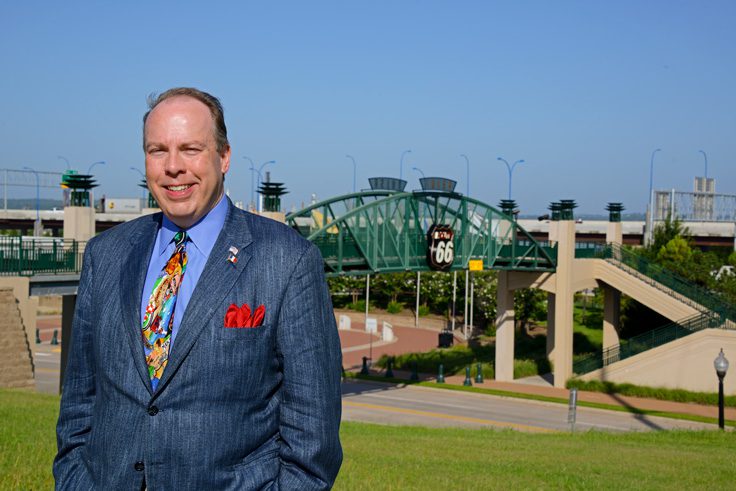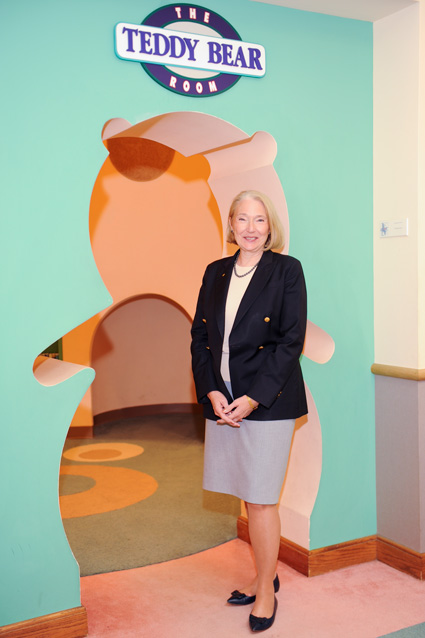
[dropcap]In[/dropcap] the 1920s, the future Father of Route 66, Tulsan Cyrus Avery, convinced the Interstate Highway Commission to take the proposed new highway through Tulsa and Oklahoma City to avoid the Rocky Mountains. Thus, the Mother Road was born.
Now, Oklahoma, a heavily traveled destination for Route 66 fans, will be home to the Route 66 Experience, a huge museum under development in Tulsa.
This celebration center for Route 66 will differ from the Oklahoma Route 66 Museum in Clinton. The Experience will not be a museum, says Ken Busby, the CEO and executive director of the Route 66 Alliance, which is spearheading the project, estimated to open in 2018.
“It’s much more than a museum,” he says. “In fact, we don’t even use the word museum. … It will have a 22,000-square-foot interpretive center with hands-on, interactive displays including a virtual road trip from Chicago to Santa Monica.”
The facility will also have restaurants, a gift shop, a drive-in movie theater and exhibit and rental spaces. It will also serve as the home for both the Oklahoma Writers Hall of Fame and the National Route 66 Hall of Fame.[pullquote]”It will highlight the 24 miles of Route 66 in Tulsa as well as how it connects to the other 2,400 miles of the Mother Road.[/pullquote]
Busby, the former director of the Tulsa Arts & Humanities Council, was asked to guide the Route 66 Alliance in 2014. The Alliance began in 2008 with a mission to bring attention to the historic highway. The alliance was co-founded by Michael Wallis, who wrote the definitive book on the highway, Route 66: The Mother Road.
“I’ve always known about Route 66,” Busby says. “Tulsa is truly where East meets West, as Tulsa is where the Mother Road turns west to head to California from Chicago. It’s such a great story that Tulsa really hasn’t told extensively.”
Busby is uniquely qualified to run the Route 66 Experience.
“My years at the Arts & Humanities Council of Tulsa prepared me well for this exciting opportunity,” says Busby, who led a successful capital campaign, which included building a new facility, while at the Council. “The tourism and economic development potential of Route 66 are tremendous,” he says.
Busby says he is excited to work with Wallis and Stevens Avery, Cyrus Avery’s grandson, along with Selser Schaefer Architects, the designers of the Hardesty Arts Center, and Ross Construction Group.
“This is an amazing team for a project that is going to make a tremendous impact on the community, and I am excited to play a role in helping make this a reality,” says Busby of the $19.5 million building project, which will be located in an area close to the Cyrus Avery Plaza at Riverside Drive and Southwest Boulevard, near the Arkansas River.
Route 66 was the first highway to be completely paved in 1938. It was a major route, because of its flatness, for truckers and travelers to the west coast and the main route for Okies escaping the Dust Bowl. When the highway was bypassed – in some cases abandoned – its continual decline seemed imminent. But in the late ‘80s, a movement to revive interest in the road began, and Route 66 associations sprang up across the road’s length.
“There are many cool stops along the highway,” Busby says of today’s Route 66. “I love the fact that the road begins in Chicago, just across the street from the Art Institute. There’s a very basic street sign that says, ‘Route 66 Begins.’”
The Route 66 Experience will engage visitors with the evolution of the road and its history.
“It’s going to tell the story of this key highway in American history and the important players that traveled the road, like Will Rogers and Woody Guthrie,” says Busby. “It will highlight the 24 miles of Route 66 in Tulsa as well as how it connects to the other 2,400 miles of the Mother Road. This new facility will have a national and international draw that will serve as a destination from which we can send visitors to explore the myriad arts and cultural venues in the greater Tulsa area, as well as across the state.”

























